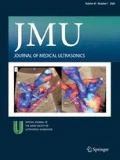Abstract
A 78-year-old woman was referred to our hospital because of general fatigue. The electrocardiogram showed ST elevation in the I, II, aVL, and V2–V6 leads. Echocardiography showed left ventricular apical akinesis. On emergent cardiac catheterization, left ventricular basal hyperkinesis and apical akinesis without coronary artery stenosis were found. The patient was diagnosed with Takotsubo cardiomyopathy. Two-dimensional myocardial speckle tracking echocardiography was performed on admission, the 8th hospital day, and the 15th hospital day. Gradual improvement in wall motion abnormality and longitudinal peak systolic strain, peak systolic strain rate, and early diastolic strain rate from the basal to apical region of the left ventricle were observed objectively, and she achieved remission. We herein report a case of Takotsubo cardiomyopathy in which objective improvement in left ventricular contraction and relaxation was observed by 2D speckle tracking imaging and bull’s eye mapping.



References
Kawai S, Kitabatake A, Tomoike H, et al. Guidelines for diagnosis of Takotsubo (ampulla) cardiomyopathy. Circ J. 2007;71:990–2.
Inoue I, Kurisu S. Takotsubo cardiomyopathy. In: Matsuzaki M, Yoshikawa J, editors. Clinical Cardiology. 1st ed. Tokyo: Bunkodo; 2006. p. 396–8.
Kawagishi T. Speckle tracking for assessment of cardiac motion and dyssynchrony. Echocardiography. 2008;25:1167–71.
Suzuki M. Diversification of the methodology for evaluating cardiac function. J Med Ultrason. 2007;34:123–4.
Kusunose K, Yamada H, Nishio S, et al. Validation of longitudinal peak systolic strain by speckle tracking echocardiography with visual assessment and myocardial perfusion SPECT in patients with regional asynergy. Circ J. 2011;75:141–7.
Gomes CB, Veras GJ. Two-dimensional strain in Takotsubo cardiomyopathy. Arq Bras Cardiol. 2010;95:35–7.
Baccouche H, Maunz M, Beck T, et al. Echocardiographic assessment and monitoring of the clinical course in a patient with Tako-Tsubo cardiomyopathy by a novel 3D-speckle tracking-strain analysis. Eur J Echocardiogr. 2009;10:729–31.
Mansencal N, Abbou N, Pillière R, et al. Usefulness of two-dimensional speckle tracking echocardiography for assessment of Tako-Tsubo cardiomyopathy. Am J Cardiol. 2009;103:1020–4.
Heggemann F, Weiss C, Hamm K, et al. Global and regional myocardial function quantification by two-dimensional strain in Takotsubo cardiomyopathy. Eur J Echocardiogr. 2009;10:760–4.
Haggemann F, Hamm K, Kaelsch T, et al. Global and regional myocardial function quantification in Takotsubo cardiomyopathy in comparison to acute anterior myocardial infarction using two-dimensional (2D) strain echocardiography. Echocardiography. 2011;28:715–9.
Mizuguchi Y, Oishi Y, Miyoshi H, et al. The functional role of longitudinal, circumferential, and radial myocardial deformation for regulating the early impairment of left ventricular contraction and relaxation in patients with cardiovascular risk factors: a study with two-dimensional strain imaging. J Am Soc Echocardiogr. 2008;21:1138–44.
Wang J, Khoury DS, Thohan V, et al. Global diastolic strain rate for the assessment of left ventricular relaxation and filling pressures. Circulation. 2007;115:1376–83.
Dokainish H, Sengupta R, Pillai M, et al. Usefulness of new diastolic strain and strain rate indexes for the estimation of left ventricular filling pressure. Am J Cardiol. 2008;101:1504–9.
Lyon AR, Rees PS, Prasad S, et al. Stress (Takotsubo) cardiomyopathy—a novel pathophysiological hypothesis to explain catecholamine-induced acute myocardial stunning. Nat Clin Pract Cardiovasc Med. 2008;5:22–9.
Villarroel AH, Vitola JV, Stier AL Jr, et al. Takotsubo or stress cardiomyopathy: role of nuclear cardiology using (123) I-MIBG. Expert Rev Cardiovasc Ther. 2009;7:847–52.
Conflict of interest
None.
Author information
Authors and Affiliations
Corresponding author
About this article
Cite this article
Ishigaki, D., Okuyama, H., Yuki, K. et al. Serial evaluation of left ventricular contraction and relaxation in Takotsubo cardiomyopathy by 2D speckle tracking echocardiography. J Med Ultrasonics 39, 265–269 (2012). https://doi.org/10.1007/s10396-012-0363-x
Received:
Accepted:
Published:
Issue Date:
DOI: https://doi.org/10.1007/s10396-012-0363-x

